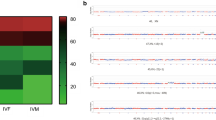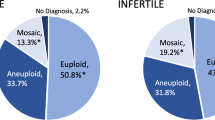Abstract
Purpose
Implantation failure is known to be associated with an increased risk of aneuploidy in embryos, a situation leading to a pre-implantation genetic screening, not allowed in different countries like France. Our aim was to evaluate the gamete aneuploidy incidence in this context, using first polar body and spermatozoa aneuploidy screening.
Methods
Three groups were considered: 11 couples with pregnancy obtained after IVF for female infertility (group 1); 20 couples with pregnancy obtained after IVF for male infertility (group 2); and 35 couples with implantation failure (group 3). In group 3, 28 couples treated by ICSI volunteered for first polar body analysis (PB1).
Results
Spermatozoa aneuploidy rate was increased in groups 2 (1.6%) and 3 (2.1%) in comparison to group 1 (0.6%). PB1 aneuploidy rate was 35.4% in group 3. Finally, eight couples (32%) had no particular chromosomal risk in gametes, 15/25 (60%) presented an increased spermatic (>2%) or oocyte (>1/3) aneuploidy rate, and 2/25 (8%) had both.
Conclusion
Those results confirm that implantation failure has a heterogeneous origin, that gamete chromosome abnormality rate is one of the major contributing factors, and that 1st Polar body and spermatozoa aneuploidy screening or pre-implantation genetics screening may be indicated for these couples.

Similar content being viewed by others
References
Griffin DK. The incidence, origin, and etiology of aneuploidy. Int Rev Cytol. 1996;167:263–96. doi:10.1016/S0074-7696(08)61349-2.
Pellestor F. Frequency and distribution of aneuploidy in human female gametes. Hum Genet. 1991;86(3):283–8. doi:10.1007/BF00202410.
Hassold T, Hunt P. To err (meiotically) is human: the genesis of human aneuploidy. Nat Rev Genet. 2001;2(4):280–91. doi:10.1038/35066065.
Vialard F, Petit C, Bergere M, Gomes DM, Martel-Petit V, Lombroso R, et al. Evidence of a high proportion of premature unbalanced separation of sister chromatids in the first polar bodies of women of advanced age. Hum Reprod. 2006;21(5):1172–8. doi:10.1093/humrep/dei484.
Kuliev A, Cieslak J, Ilkevitch Y, Verlinsky Y. Chromosomal abnormalities in a series of 6,733 human oocytes in preimplantation diagnosis for age-related aneuploidies. Reprod Biomed Online. 2003;6(1):54–9.
Pellestor F, Andreo B, Arnal F, Humeau C, Demaille J. Maternal aging and chromosomal abnormalities: new data drawn from in vitro unfertilized human oocytes. Hum Genet 2003;112(2):195–203.
Gianaroli L, Magli MC, Ferraretti AP, Munne S. Preimplantation diagnosis for aneuploidies in patients undergoing in vitro fertilization with a poor prognosis: identification of the categories for which it should be proposed. Fertil Steril. 1999;72(5):837–44. doi:10.1016/S0015-0282(99)00377-5.
Kahraman S, Benkhalifa M, Donmez E, Biricik A, Sertyel S, Findikli N, et al. The results of aneuploidy screening in 276 couples undergoing assisted reproductive techniques. Prenat Diagn. 2004;24(4):307–11. doi:10.1002/pd.842.
Sermon KD, Michiels A, Harton G, Moutou C, Repping S, Scriven PN, et al. ESHRE PGD consortium data collection VI: cycles from January to December 2003 with pregnancy follow-up to October 2004. Hum Reprod. 2007;22(2):323–36. doi:10.1093/humrep/del402.
Mantzouratou A, Mania A, Fragouli E, Xanthopoulou L, Tashkandi S, Fordham K, et al. Variable aneuploidy mechanisms in embryos from couples with poor reproductive histories undergoing preimplantation genetic screening. Hum Reprod. 2007;22(7):1844–53. doi:10.1093/humrep/dem102.
Vialard F, Lombroso R, Bergere M, Gomes DM, Hammoud I, Bailly M, et al. Oocyte aneuploidy mechanisms are different in two situations of increased chromosomal risk: older patients and patients with recurrent implantation failure after in vitro fertilization. Fertil Steril. 2007;87(6):1333–9. doi:10.1016/j.fertnstert.2006.11.042.
Pagidas K, Ying Y, Keefe D. Predictive value of preimplantation genetic diagnosis for aneuploidy screening in repeated IVF-ET cycles among women with recurrent implantation failure. J Assist Reprod Genet. 2008;25(2–3):103–6. doi:10.1007/s10815-008-9200-y.
Urman B, Yakin K, Balaban B. Recurrent implantation failure in assisted reproduction: how to counsel and manage. B. Treatment options that have not been proven to benefit the couple. Reprod Biomed Online. 2005;11(3):382–91.
Montag M, van der Ven K, Dorn C, van der Ven H. Outcome of laser-assisted polar body biopsy and aneuploidy testing. Reprod Biomed Online. 2004;9(4):425–9.
Hassold T, Abruzzo M, Adkins K, Griffin D, Merrill M, Millie E, et al. Human aneuploidy: incidence, origin, and etiology. Environ Mol Mutagen. 1996;28(3):167–75. doi:10.1002/(SICI)1098-2280(1996)28:3<167::AID-EM2>3.0.CO;2-B.
Nicolaidis P, Petersen MB. Origin and mechanisms of non-disjunction in human autosomal trisomies. Hum Reprod. 1998;13(2):313–9. doi:10.1093/humrep/13.2.313.
Van Steirteghem A, Bonduelle M, Devroey P, Liebaers I. Follow-up of children born after ICSI. Hum Reprod Update. 2002;8(2):111–6. doi:10.1093/humupd/8.2.111.
Liebaers I, Bonduelle M, Van Assche E, Devroey P, Van Steirteghem A. Sex chromosome abnormalities after intracytoplasmic sperm injection. Lancet. 1995;346(8982):1095. doi:10.1016/S0140-6736(95)91768-3.
Petit FM, Frydman N, Benkhalifa M, Le Du A, Aboura A, Fanchin R, et al. Could sperm aneuploidy rate determination be used as a predictive test before intracytoplasmic sperm injection? J Androl. 2005;26(2):235–41.
Rubio C, Gil-Salom M, Simon C, Vidal F, Rodrigo L, Minguez Y, et al. Incidence of sperm chromosomal abnormalities in a risk population: relationship with sperm quality and ICSI outcome. Hum Reprod. 2001;16(10):2084–92. doi:10.1093/humrep/16.10.2084.
Calogero AE, Burrello N, De Palma A, Barone N, D’Agata R, Vicari E. Sperm aneuploidy in infertile men. Reprod Biomed Online. 2003;6(3):310–7.
Guthauser B, Vialard F, Dakouane M, Izard V, Albert M, Selva J. Chromosomal analysis of spermatozoa with normal-sized heads in two infertile patients with macrocephalic sperm head syndrome. Fertil Steril. 2006;85(3):750 e5–750 e7.
Devillard F, Metzler-Guillemain C, Pelletier R, DeRobertis C, Bergues U, Hennebicq S, et al. Polyploidy in large-headed sperm: FISH study of three cases. Hum Reprod. 2002;17(5):1292–8. doi:10.1093/humrep/17.5.1292.
Rives N, Mousset-Simeon N, Mazurier S, Mace B. Primary flagellar abnormality is associated with an increased rate of spermatozoa aneuploidy. J Androl. 2005;26(1):61–9.
Dam AH, Feenstra I, Westphal JR, Ramos L, van Golde RJ, Kremer JA. Globozoospermia revisited. Hum Reprod Update, 2006.
Ditzel N, El-Danasouri I, Just W, Sterzik K. Higher aneuploidy rates of chromosomes 13, 16, and 21 in a patient with globozoospermia. Fertil Steril. 2005;84(1):217–8. doi:10.1016/j.fertnstert.2005.01.109.
Gianaroli L, Magli MC, Ferraretti AP, Tabanelli C, Trengia V, Farfalli V, et al. The beneficial effects of preimplantation genetic diagnosis for aneuploidy support extensive clinical application. Reprod Biomed Online. 2005;10(5):633–40.
Findikli N, Kahraman S, Saglam Y, Beyazyurek C, Sertyel S, Karlikaya G, et al. Embryo aneuploidy screening for repeated implantation failure and unexplained recurrent miscarriage. Reprod Biomed Online. 2006;13(1):38–46.
Shi Q, Martin RH. Aneuploidy in human spermatozoa: FISH analysis in men with constitutional chromosomal abnormalities, and in infertile men. Reproduction. 2001;121(5):655–66. doi:10.1530/rep.0.1210655.
Gianaroli L, Magli MC, Cavallini G, Crippa A, Nadalini M, Bernardini L, et al. Frequency of aneuploidy in sperm from patients with extremely severe male factor infertility. Hum Reprod, 2005.
Machev N, Gosset P, Viville S. Chromosome abnormalities in sperm from infertile men with normal somatic karyotypes: teratozoospermia. Cytogenet Genome Res. 2005;111(3–4):352–7. doi:10.1159/000086910.
Bartoov B, Berkovitz A, Eltes F, Kogosovsky A, Yagoda A, Lederman H, et al. Pregnancy rates are higher with intracytoplasmic morphologically selected sperm injection than with conventional intracytoplasmic injection. Fertil Steril. 2003;80(6):1413–9. doi:10.1016/j.fertnstert.2003.05.016.
Hazout A, Dumont-Hassan M, Junca AM, Cohen Bacrie P, Tesarik J. High-magnification ICSI overcomes paternal effect resistant to conventional ICSI. Reprod Biomed Online. 2006;12(1):19–25.
Verlinsky Y, Cieslak J, Ivakhnenko V, Evsikov S, Wolf G, White M, et al. Prevention of age-related aneuploidies by polar body testing of oocytes. J Assist Reprod Genet. 1999;16(4):165–9. doi:10.1023/A:1020304621338.
Pellestor F, Andreo B, Arnal F, Humeau C, Demaille J. Mechanisms of non-disjunction in human female meiosis: the co-existence of two modes of malsegregation evidenced by the karyotyping of 1397 in-vitro unfertilized oocytes. Hum Reprod. 2002;17(8):2134–45. doi:10.1093/humrep/17.8.2134.
Caglar GS, Asimakopoulos B, Nikolettos N, Diedrich K, Al-Hasani S. Preimplantation genetic diagnosis for aneuploidy screening in repeated implantation failure. Reprod Biomed Online. 2005;10(3):381–8.
Pang MG, Hoegerman SF, Cuticchia AJ, Moon SY, Doncel GF, Acosta AA, et al. Detection of aneuploidy for chromosomes 4, 6, 7, 8, 9, 10, 11, 12, 13, 17, 18, 21, X and Y by fluorescence in-situ hybridization in spermatozoa from nine patients with oligoasthenoteratozoospermia undergoing intracytoplasmic sperm injection. Hum Reprod. 1999;14(5):1266–73. doi:10.1093/humrep/14.5.1266.
Margalioth EJ, Ben-Chetrit A, Gal M, Eldar-Geva T. Investigation and treatment of repeated implantation failure following IVF-ET. Hum Reprod. 2006;21(12):3036–43. doi:10.1093/humrep/del305.
Ledee N, Chaouat G, Serazin V, Lombroso R, Dubanchet S, Oger P, et al. Endometrial vascularity by three-dimensional power Doppler ultrasound and cytokines: a complementary approach to assess uterine receptivity. J Reprod Immunol. 2008;77(1):57–62. doi:10.1016/j.jri.2007.07.006.
Fragouli E, Wells D, Thornhill A, Serhal P, Faed MJ, Harper JC, et al. Comparative genomic hybridization analysis of human oocytes and polar bodies. Hum Reprod. 2006;21(9):2319–28. doi:10.1093/humrep/del157.
Author information
Authors and Affiliations
Corresponding author
Rights and permissions
About this article
Cite this article
Vialard, F., Hammoud, I., Molina-Gomes, D. et al. Gamete cytogenetic study in couples with implantation failure: aneuploidy rate is increased in both couple members. J Assist Reprod Genet 25, 539–545 (2008). https://doi.org/10.1007/s10815-008-9258-6
Received:
Accepted:
Published:
Issue Date:
DOI: https://doi.org/10.1007/s10815-008-9258-6




